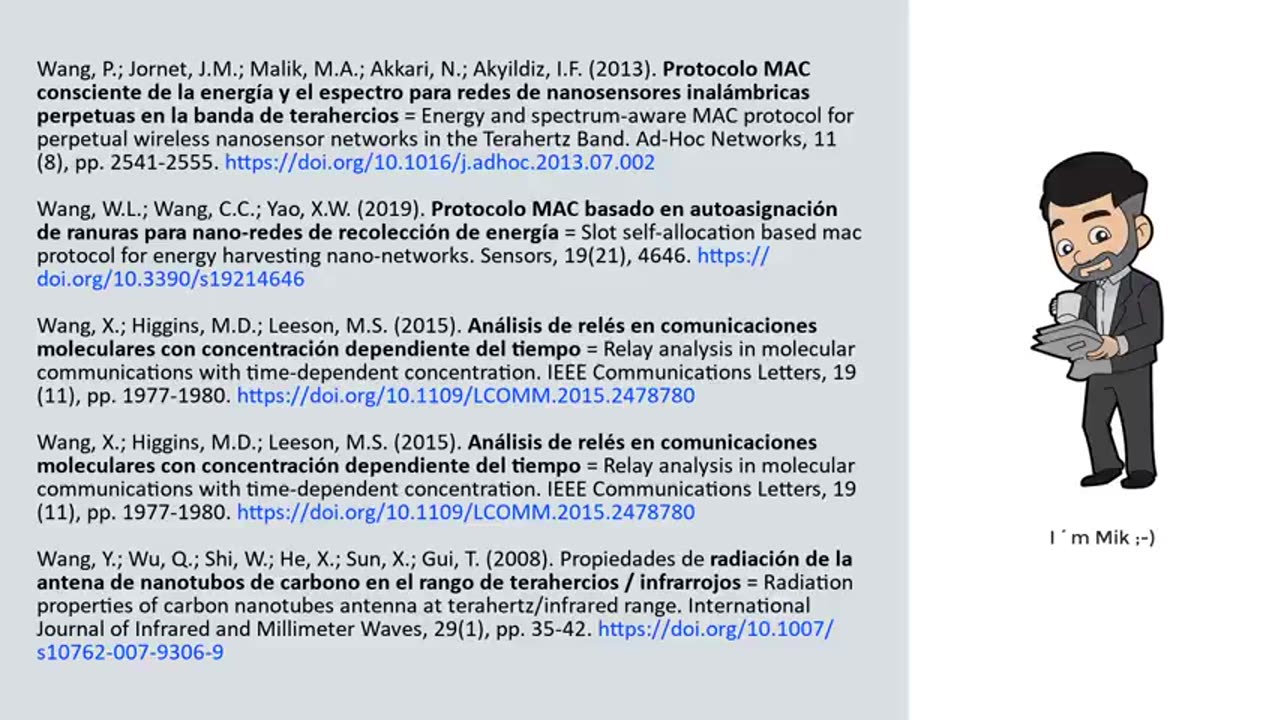Premium Only Content

Intra-body nano-network - REFS ONLY
*** JUST THE REFERENCES ***
Mik Andersen, via a synthesized voice puts together a hypothesis based on the scientific literature regarding nanotechnology, to compare with what has been discovered in Prof Campra's research of the studied vials.
Full Presentation: (24 mins)
https://rumble.com/v2llg3a-intra-body-nano-network-full-presentation-english.html
Download Intra-body nano-network - Brief Summary by Mik Andersen:
https://docdro.id/tvx0R9b
What’s In The Vials? (Prof. Dr. Pablo Campra)
https://pennybutler.com/spain-vials-pablo-campra/
Download - FINAL TECHNICAL REPORT ON GRAPHENE DETECTION IN COVID VACCINES where the presence of Graphene Oxide is determined in the samples from Pfzer, Astrazeneca, Moderna and Janssen
https://www.dropbox.com/s/tnnq4ftw818chmx/FINAL_VERSI%C3%93N_CAMPRA_REPORT_DETECTION_GRAPHENE_IN_COVID19_VACCINES.pdf?dl=0
REFERENCES:
Abbasi, E.; Akbarzadeh, A.; Kouhi, M.; Milani, M. (2016). Graphene: synthesis, bio-applications, and properties. Artificial cells, nanomedicine, and biotechnology , 44 (1), pp. 150-156. https://doi.org/10.3109/21691401.2014.927880
Abbasi, QH; El-Sallabi, H.; Chopra, N.; Yang, K.; Qaraqe, K. A.; Alomainy, A. (2016). Terahertz channel characterization inside the human skin for nano-scale body-centric networks. IEEE Transactions on Terahertz Science and Technology , 6 (3), pp. 427-434. https://doi.org/10.1109/TTHZ.2016.2542213
Abbasi, QH; Nasir, AA; Yang, K.; Qaraqe, K. A.; Alomainy, A. (2017). Cooperative in-vivo nano-network communication at terahertz frequencies. IEEE Access , 5 , pp. 8642-8647. https://doi.org/10.1109/ACCESS.2017.2677498
Abd-El-atty, SM; Heddles, K.A.; Gharsseldien, ZM; Tolba, A.; Makhadmeh, ZA (2018). Engineering molecular communications integrated with carbon nanotubes in neural sensor nanonetworks. IET Nanobiotechnology , 12 (2), pp. 201-210. https://ietresearch.onlinelibrary.wiley.com/doi/pdfdirect/10.1049/iet-nbt.2016.0150
Akyildiz, IF; Jornet, JM; Pierobon, M. (2010). Propagation models for nanocommunication networks. In: Proceedings of the Fourth European Conference on Antennas and Propagation (pp. 1-5). IEEE. https://ieeexplore.ieee.org/abstract/document/5505714
Aliouat, L.; Rahmani, M.; Mabed, H.; Bourgeois, J. (2021). Enhancement and performance analysis of channel access mechanisms in terahertz band. Nano Communication Networks , 29 , 100364. https://doi.org/10.1016/j.nancom.2021.100364
Alsheikh, R.; Akkari, N.; Fadel, E. (2016). MAC protocols for wireless nano-sensor networks: Performance analysis and design guidelines. In: 2016 Sixth International Conference on Digital Information Processing and Communications (ICDIPC) (pp. 129-134). IEEE. https://doi.org/10.1109/ICDIPC.2016.7470805
Balghusoon, AO; Mahfoudh, S. (2020). Routing protocols for wireless nanosensor networks and internet of nano things: a comprehensive survey. IEEE Access , 8 , pp. 200724-200748. https://doi.org/10.1109/ACCESS.2020.3035646
Bareket-Keren, L.; Hanein, Y. (2013). Carbon nanotube-based multi electrode arrays for neuronal interfacing: progress and prospects. Frontiers in neural circuits , 6 , 122. https://doi.org/10.3389/fncir.2012.00122
Bezalel, N.; Ishai, PB; Feldman, Y. (2018). The human skin as a sub-THz receiver–Does 5G pose a danger to it or not?. Environmental research , 163 , pp. 208-216. https://doi.org/10.1016/j.envres.2018.01.032
Bouchedjera, IA; Louail, L.; Aliouat, Z.; Harous, S. (2020). DCCORONA: Distributed Cluster-based Coordinate and Routing System for Nanonetworks. In: 2020 11th IEEE Annual Ubiquitous Computing, Electronics & Mobile Communication Conference (UEMCON) (pp. 0939-0945). IEEE. https://doi.org/10.1109/UEMCON51285.2020.9298084
Gabay, T.; Jakobs, E.; Ben-Jacob, E.; Hanein, Y. (2005). Engineered self-organization of neural networks using carbon nanotube clusters. Physica A: Statistical Mechanics and its Applications , 350 (2-4), pp. 611-621. https://doi.org/10.1016/j.physa.2004.11.007
Ghafoor, S.; Boujnah, N.; Rehmani, MH; Davy, A. (2020). MAC protocols for terahertz communication: A comprehensive survey. IEEE Communications Surveys & Tutorials , 22 (4), pp. 2236-2282. https://doi.org/10.1109/COMST.2020.3017393
Han, M.; Karatum, O.; Nizamoglu, S. (2022). Optoelectronic Neural Interfaces Based on Quantum Dots. ACS Applied Materials & Interfaces . https://doi.org/10.1021/acsami.1c25009
Hejazi, M.; Tong, W.; Ibbotson, MR; Prawer, S.; Garrett, D.J. (2021). Advances in carbon-based microfiber electrodes for neural interfacing. Frontiers in Neuroscience , 15 , 403. https://doi.org/10.3389/fnins.2021.658703
Hossain, Z.; Vedant, S.H.; Nicoletti, CR; Federici, J.F. (2016). Multi-user interference modeling and experimental characterization for pulse-based terahertz communication. In: Proceedings of the 3rd ACM International Conference on Nanoscale Computing and Communication (pp. 1-6). https://doi.org/10.1145/2967446.2967462
Hosseininejad, SE; Abadal, S.; Neshat, M.; Faraji-Dana, R.; Lemme, MC; Suessmeier, C.; Cabellos-Aparicio, A. (2018). MAC-oriented programmable terahertz PHY via graphene-based Yagi-Uda antennas. In: 2018 IEEE Wireless Communications and Networking Conference (WCNC) (pp. 1-6). IEEE. https://doi.org/10.1109/WCNC.2018.8377201
Kulakowski, P.; Turbic, K.; Correia, L.M. (2020). From nano-communications to body area networks: A perspective on truly personal communications. IEEE Access , 8 , pp. 159839-159853. https://doi.org/10.1109/ACCESS.2020.3015825
Le, TN; Pegatoquet, A.; Magno, M. (2015). Asynchronous on demand MAC protocol using wake-up radio in wireless body area network. In: 2015 6th International Workshop on Advances in Sensors and Interfaces (IWASI) (pp. 228-233). IEEE. https://doi.org/10.1109/IWASI.2015.7184942
Lemic, F.; Abadal, S.; Tavernier, W.; Stroobant, P.; Colle, D.; Alarcon, E.; Famaey, J. (2021). Survey on terahertz nanocommunication and networking: A top-down perspective. IEEE Journal on Selected Areas in Communications , 39 (6), pp. 1506-1543. https://doi.org/10.1109/JSAC.2021.3071837
Lovat, V.; Pantarotto, D.; Lagostena, L.; Cacciari, B.; Grandolfo, M.; Righi, M.; Ballerini, L. (2005). Carbon nanotube substrates boost neuronal electrical signaling. Nanoletters , 5 (6), pp. 1107-1110. https://doi.org/10.1021/nl050637m
Martinelli, V.; Cellot, G.; Fabbro, A.; Bosi, S.; Mestroni, L.; Ballerini, L. (2013). Improving cardiac myocytes performance by carbon nanotubes platforms. Frontiers in physiology , 4 , 239. https://doi.org/10.3389/fphys.2013.00239
Medlej, A.; Dedu, E.; Dhoutaut, D.; Beydoun, K. (2022). Efficient Retransmission Algorithm for Ensuring Packet Delivery to Sleeping Destination Node. In: International Conference on Advanced Information Networking and Applications (pp. 219-230). Springer, Cham. https://doi.org/10.1007/978-3-030-99587-4_19
Menard-Moyon, C. (2018). Applications of carbon nanotubes in the biomedical field. In: Smart nanoparticles for biomedicine (pp. 83-101). Elsevier. https://doi.org/10.1016/B978-0-12-814156-4.00006-9
Mezher, MA; Din, S.; Ilyas, M.; Bayat, O.; Abbasi, QH; Ashraf, I. (2022). Data Transmission Enhancement Using Optimal Coding Technique Over In Vivo Channel for Interbody Communication. Big Data . https://doi.org/10.1089/big.2021.0224
Nussenbaum, K.; Cohen, AO (2018). Equation Invasion! How Math can Explain How the Brain Learns. http://doi.org/10.3389/frym.2018.00065
Bread, K.; Leng, T.; Song, J.; Ji, C.; Zhang, J.; Li, J.; Hu, Z. (2020). Controlled reduction of graphene oxide laminate and its applications for ultra-wideband microwave absorption. Carbon , 160 , pp. 307-316. https://doi.org/10.1016/j.carbon.2019.12.062
Piro, G.; Bia, P.; Boggia, G.; Caratelli, D.; Grieco, LA; Mescia, L. (2016). Terahertz electromagnetic field propagation in human tissues: A study on communication capabilities. Nano Communication Networks , 10 , pp. 51-59. https://doi.org/10.1016/j.nancom.2016.07.010
Rauti, R.; Musto, M.; Bosi, S.; Prato, M.; Ballerini, L. (2019). Properties and behavior of carbon nanomaterials when interfacing neuronal cells: How far have we come?. Carbon , 143 , pp. 430-446. https://doi.org/10.1016/j.carbon.2018.11.026
Rikhtegar, N.; Keshtgari, M.; Ronaghi, Z. (2017). EEWNSN: Energy efficient wireless nano sensor network MAC protocol for communications in the terahertz band. Wireless Personal Communications , 97 (1), pp. 521-537. https://doi.org/10.1007/s11277-017-4517-4
Sarlange, G.; Devilger, J.; Trillaud, P.; Fouchet, S.; Taillasson, L.; Catteu, G. (2021). Project Bluetooth Experience X. https://ln5.sync.com/dl/195df4a10/5ab9apq6-q5vgawam-vgr3ktt9-7zr985rh
Sivapriya, S.; Sridharan, D. (2017). Energy Efficient MAC Protocol for Body Centric Nano-Networks (BANNET). ADVANCED COMPUTING (ICoAC 2017) , 422.
Vavouris, AK; Dervisi, FD; Papanikolaou, VK; Karagiannidis, GK (2018). An energy efficient modulation scheme for body-centric nano-communications in the THz band. In: 2018 7th International Conference on Modern Circuits and Systems Technologies (MOCAST) (pp. 1-4). IEEE. https://doi.org/10.1109/MOCAST.2018.8376563
Yang, K.; Bi, D.; Deng, Y.; Zhang, R.; Rahman, MMU; Ali, N.A.; Alomainy, A. (2020). A comprehensive survey on hybrid communication in context of molecular communication and terahertz communication for body-centric nanonetworks. IEEE Transactions on Molecular, Biological and Multi-Scale Communications , 6 (2), pp. 107-133. https://doi.org/10.1109/TMBMC.2020.3017146
Yin, P.; Liu, Y.; Xiao, L.; Zhang, C. (2021). Advanced Metallic and Polymeric Coatings for Neural Interfacing: Structures, Properties and Tissue Responses. Polymers , 13 (16), 2834. https://doi.org/10.3390/polym13162834
Yuan, C.; Tony, A.; Yin, R.; Wang, K.; Zhang, W. (2021). Tactile and thermal sensors built from carbon–polymer nanocomposites—A critical review. Sensors , 21 (4), 1234. https://doi.org/10.3390/s21041234
Zhang, R.; Yang, K.; Abbasi, QH; Qaraqe, K. A.; Alomainy, A. (2017). Analytical characterization of the terahertz in-vivo nano-network in the presence of interference based on TS-OOK communication scheme. IEEE Access , 5 , pp. 10172-10181. https://doi.org/10.1109/ACCESS.2017.2713459
Zhang, Y.; Yang, C.; Yang, D.; Shao, Z.; Hu, Y.; Chen, J.; Wang, L. (2018). Reduction of graphene oxide quantum dots to enhance the yield of reactive oxygen species for photodynamic therapy. Physical Chemistry Chemical Physics , 20 (25), pp. 17262-17267. https://doi.org/10.1039/C8CP01990H
Part One: Summary & MAC phenomenon (3min)
Part 1 summarizes the presentation and gives instructions on how to test the Bluetooth/MAC address phenomenon for yourself.
https://pennybutler.com/intrabody-nanonetwork-part-one/
https://rumble.com/v2llhsi-intra-body-nano-network-part-15.html
Part Two: Intra-Body Nano-Network: Graphene quantum dots / Nanonodes (3min)
Part 2 of 5 of the Intra Body Nano Network by Mik Andersen. Part two introduces micro or nanoscale devices using graphene quantum dots, which, if present inside the human body can make up an Intracorporal Wireless Network of Nano Communications.
https://pennybutler.com/intrabody-nanonetwork-part-two/
https://rumble.com/v2llipk-intra-body-nano-network-part-2-of-5.html
Part Three: Micro/Nanointerface, Micro/Nano routers/sensors, TS-OOK signals, Gateway. (5min)
Part 3 is really the meat & potatoes of the presentation. It goes through what is in the scientific literature regarding micro and nano sensors, carbon nanotubes, graphene and graphene oxide nanosheets, Micro and Nano routers. micro antennas or plasmonic nanoantennae microsensors, micro node signals (TS-OOK) and how our phone, tablet or can be used as the gateway.
https://pennybutler.com/intrabody-nanonetwork-part-three/
https://rumble.com/v2llj0g-intra-body-nano-network-part-3-of-5.html
Part Four: Possible Uses: Mind-control & Population control: Neurosurveillance, Neuromodulation, Neurostimulation, Human connectivity (4min)
Part 4 is about hypothesizing if this technology is in us, what it could be used for.
https://pennybutler.com/intrabody-nanonetwork-part-four/
https://rumble.com/v2lljos-intra-body-nano-network-part-4-of-5.html
Part Five: Possible Uses: Social Credit System, Eugenics, Targeted traceless weapon, & Refs (3min)
Part 5 continues hypothesizing if this technology is in us, what it could be used for on a more devastating level regarding population control, selective genocide, and eugenics. This post also contains the references he listed in his presentation. (4min)
https://pennybutler.com/intrabody-nanonetwork-part-five/
https://rumble.com/v2llk20-intra-body-nano-network-part-5-of-5.html
-
 13:18
13:18
Censored Important Videos
4 months agoHow to Block Facial Recognition Cameras (IRL Tested!)
1.65K3 -
 LIVE
LIVE
The Quartering
14 hours agoThanksgiving Day Yule Log!
1,713 watching -
 15:32
15:32
IsaacButterfield
22 hours ago $3.96 earnedAussie Reacts To UNHINGED Woke TikToks!
20.5K10 -
 3:24:28
3:24:28
PandaSub2000
14 hours agoNintendo Platformers - Thanksgiving 2025 Special | ULTRA BEST AT GAMES (Original Live Version)
41.5K8 -
 1:03:06
1:03:06
MetatronGaming
1 day agoThis is the scariest game ever (for an Italian)
28.9K10 -
 1:09:35
1:09:35
The White House
9 hours agoPresident Trump Participates in a Call with Service Members
50K86 -
 5:20:01
5:20:01
a12cat34dog
8 hours agoHAPPY THANKSGIVING - I APPRECIATE YOU ALL SO MUCH {18+}
25.1K4 -
 24:55
24:55
Jasmin Laine
1 day agoCarney BRAGS About ‘Investment’—Poilievre Drops a FACT That Stops the Room
32.2K29 -
 2:14:15
2:14:15
SIM_N_SHIFT GAMING
7 hours ago $1.64 earnedGRAND THEFT AUTO WITH FRIENDS
16.6K -
 6:43:27
6:43:27
VikingNilsen
17 hours ago🔴LIVE - VIKINGNILSEN - THE NEW PRELUDE - SOULFRAME
14.9K